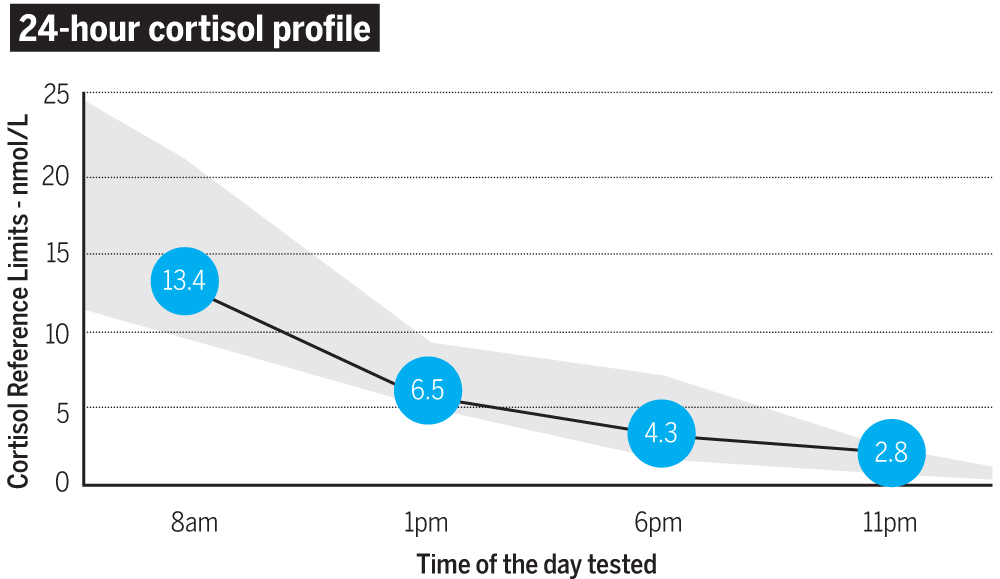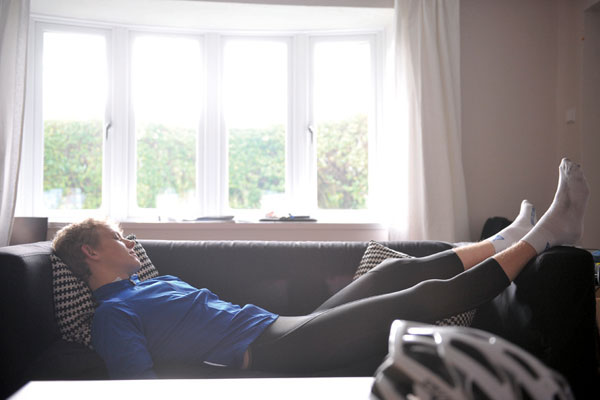Is your adrenal system making you tired?
Vicky Ware takes a look at adrenal fatigue and its symptoms, how it affects your cycling and how to cure it

Photo: Jesse Wild
Adrenal fatigue is basically an alternative term for burnout or overtraining syndrome; the three terms are used synonymously, and while they have different subtleties, they are trespassing on the same territory. Each one describes the outcome of doing too much exercise with too little recovery.
The symptoms and causes of adrenal fatigue are not fully agreed upon by the medical community, as Dr Tamsin Lewis explains: “Generally, among conventional medical doctors, adrenal fatigue is not an accepted term. However, an endocrinologist will accept that hypothalamic-pituitary-adrenal (HPA) axis dysfunction is a very real phenomenon.”
Read more on fatigue

How to tell whether you are overtraining, and how to avoid it
It's easy to think that racking up endless miles will be beneficial to your cycling, but it's all too easy
HPA refers to the stress-response system, activated when you confront a psychological, emotional or physical stressor. The HPA axis, also known as the ‘fight or flight’ response, triggers a cascade of events that results in the adrenal glands secreting cortisol — a so-called ‘stress hormone’. In the short term, this is good news, as it helps you respond swiftly and powerfully to the stress.
In the longer term, it may have a detrimental impact.
“Some people, if stressed over a long period of time may develop a syndrome whereby the body is no longer able to mount a stress response. Effectively, the precursor molecules to cortisol become depleted. Some people may develop [a shortfall] quicker than others.”
The latest race content, interviews, features, reviews and expert buying guides, direct to your inbox!
Four signs to look for
1. Disrupted sleep
2. Night sweats
3. Low immunity
4. Muscle soreness
Cortisol causes the release of glucose from glycogen stores in the liver and muscles to help fuel your fight or flight. This happens when you ride your bike at over 80 per cent of VO2 max. It also causes the release of amino acids from muscle and glycerol from fat stores. The physical effort triggers the release of testosterone and human growth hormone, both of which help repair muscle and restore energy left over in the bloodstream.
>>> Can amateur cyclists benefit from blood analysis?
This acute stress isn’t a bad thing, as long as you give your body the time and nutrition it needs to adapt — it’s how training improves fitness. The problem arises when your body is constantly stressed.
“Stress can be mental as well as physical, and accrues. For example, if you sleep poorly, have work stress and do high-intensity exercise fuelled by caffeine and a nutrient-poor diet, you are more prone to adrenal fatigue,” explains Lewis.
>>> Should you really train like a pro?
Other stressors include exercising on a diet too low in carbohydrate, dehydration and micronutrient deficiencies. Unfortunately for the ‘work hard, play hard’ generation, it seems to be true that you can’t burn the candle at both ends.
>>> Astana suspended from MPCC over Lars Boom cortisol test
Ultimately, the adrenal glands will stop producing cortisol, and it’s not just amateur cyclists with full-time jobs who need worry. Professional cyclists also have their cortisol levels monitored, as it can indicate underlying illness and even doping.

How do you know you’ve got it?
Symptoms you should look out for include disrupted sleep, night sweats, low immunity, muscle soreness, allergies, brain fogginess and an excessive need to urinate.
HPA axis dysfunction presents as irregular or absent periods in women and low sex drive or low energy and muscle fatigue in men,” says Lewis. You may suffer from all or only some of these.
Blood tests for hormone levels are one way to determine exactly what is going on. However, cortisol naturally fluctuates throughout the day, making testing for ‘normal’ levels difficult.
“A four-point saliva DHEA [dehydroepiandrosterone]/cortisol panel is helpful, as it shows the change in cortisol levels over the day,” explains Lewis. This tests saliva levels of cortisol and the hormone DHEA, helping to determine whether they’re being produced in the right amounts at the right time. A 24-hour cycle during which the levels are flat, with no peaks and troughs, is a sign your adrenal system may be fatigued.
>>> How to use nitrate to boost cycling performance
Epic-Scott Contessa rider Emma Grant has first-hand experience of adrenal fatigue. What were the first signs?
“I sucked on the bike and I was just about functioning off the bike,” she explains. “I was exhausted mentally and physically.”
How long ago did it take to realise things weren’t right?

“It was a progressive decline. In hindsight, I look back five years and there were warning signs that I chose to ignore and deemed normal for an endurance athlete,” she says.
This is perhaps all too common among budding cyclists. Unlike rowers or runners who typically start training in school or under a coach in a controlled environment, cyclists tend to train independently, and inappropriately hard.
>>> Seven simple steps to be a successful cyclist
“I cringe at how I used to train,” says Grant. “I spent the whole winter in my big ring, as someone told me the 39 was the granny ring. I did lactate intervals when I had fevers and a gym day with weights was a recovery day for me. Crazy.”
How to get better

Recovery from adrenal fatigue can be a long, difficult process. It often requires you to change the way you’re thinking about training and life in general.
Lewis finds that, “Most athletes don’t want to hear the standard doctor advice to do less.” Another key is focusing on what you’re doing, and not trying to do more than everyone you follow on Strava.
>>> Seven amazing things you didn’t know Strava could do
“Comparing your training to peers is unhelpful,” says Lewis.
Finding experts who have evidence-based practical methods to help you recover is a big hurdle to overcome. “I am only now finding really good professionals to work with. I saw a lot of lousy people who saw no hope in my situation and helping get to where I want to go long-term. That didn’t help the process of recovering. Having a good team around you is key,” Grant advises.
Nutrition
One aspect that will definitely pay dividends is making sure your diet fuels a healthy body, not a decline into hormonal disarray. “Nutrition was huge for me,” explains Grant, “I am a big believer in the healing power of food. My approach was eating real food, a clean diet and easy-to-digest, well-cooked or blended foods. I also ate lots of bone broth.”
>>> How to make your own recovery bars (videos)
As well as eating whole foods, Grant took supplements. “I followed a supplement protocol religiously to address deficiencies such as magnesium and coenzyme Q10,” she explains. “B-vitamins can help support the adrenal glands, as can magnesium. I often advise Natural Calm Magnesium Citrate or aspartate for athletes, as it helps reset the sympathetic nervous system,” says Lewis.
Sodium intake

Salt craving is a common symptom of adrenal fatigue. As a cyclist, you sweat out a lot of sodium, and many of us avoid high-sodium foods because of the associated health risks. Those with adrenal fatigue retain too little sodium due to a lack of aldosterone, a hormone secreted by the adrenal glands that regulates how much sodium the kidneys excrete.
>>> Adding salt to sports drinks can improve performance, research suggests
This lack of sodium causes decreased blood volume, as the altered salt balance stops water being retained by the kidneys, and the drop in blood pressure means you feel dizzy when you stand up. Increased blood volume is seen in fit athletes, and improves your performance, so a reduced blood volume will negatively impact cycling performance.
Eat enough carbohydrate

“Much has been touted about the benefits of adapting to a low-carbohydrate diet for endurance athletes,” says Lewis, “but through years of testing and reading the literature [I’ve found] most women perform poorly on consistently low-carb diets, even if fat-adapted.
>>> How to fuel for long distance rides
“Thyroid function becomes impaired, mood altered, especially pre-menstrually, and cortisol levels are constantly high.”
Training with inadequate carbohydrate promotes the release of cortisol, as it’s necessary to release energy from fat and muscle.
Get stronger to prevent injury
Support immune health
Cortisol is anti-inflammatory; it acts to reduce the ability of the immune system to respond. When cortisol is high for too long, this dampening down of the immune response can lead to shrinking in size of immune organs such as the lymph nodes.
This is bad news because it means you’re less able to respond to potentially serious threats like bacterial infection, and are less able to recover after hard training.
>>> What to do (and what not to do) after every bike ride (video)
Low cortisol is also the reason adrenal fatigue may cause increased allergic responses, since the natural anti-inflammatory isn’t available to dampen immune responses to innocuous irritants such as pollen.
The solution is getting more rest and ensuring your diet contains adequate fat, which is essential for building the cells of the immune system and building hormones.
Get enough sleep
Sleep is very important when it comes to adrenal health, so good sleep hygiene is a must. That means getting to bed at the same time every night and getting up at the same time every morning. Sleeping for 14 hours the one time you don’t set an alarm isn’t a good sign in terms of your hormonal function.
Reducing exposure to blue-light-emitting screens such as your laptop and phone late at night is one way to improve sleep quality. Research has shown that exposure to this reduces secretion of melatonin in the brain and sleep quality.
Less volume, more quality
Doing junk miles is not the answer to improving adrenal health. “Many do better with more intensity and less volume,” says Lewis.
>>> Tips for effective rest and recovery after cycling
If you think you might be teetering on the edge of adrenal fatigue, cut your training hours back while maintaining short intervals of less than three minutes in duration and get rid of any long, medium-paced rides which are fatiguing without the gains.”
Kick the caffeine
“Some people who are perhaps more at risk for adrenal fatigue need a large amount of caffeine to kick-start their adrenal system in the morning.
“This is fine for short periods but not sustained over months or years without periods of recovery and abstinence,” explains Lewis. If you can’t imagine your life without coffee, try going caffeine-free for a week during recovery periods.
Learn to relax
Grant disciplined herself to incorporate relaxation into her schedule.
“Learning to stress less was paramount,” she explains. “I got really into yoga and didn’t feel the need to be competitive in class which is a victory when you are a strong type-A [personality type].”
Giving your adrenal glands a break is one reason to have regular recovery periods in training, and why if you’re not already exhausted, a recovery ride may help. It improves circulation and improves immune system response to infection while not activating the stress response system. Realise it’s not merely OK to rest, but essential.
>>> Find your perfect pace to optimise cycling performance
Cyclists like to talk about ‘going hard or going home’, and enjoying time in the ‘pain cave’ — which may make it difficult to talk to your cycling peers about feeling tired and needing rest. People suffering from burnout may feel they’re not supported by those around them, who may not take their exhaustion seriously.
Exercise may also become an addiction. “We put exercise, or avoidance of dealing with issues first — as many of us are addicts — and the endorphin buzz of exercise encourages us to repeat the behaviour. I see people do this for years and then be knocked out by chronic fatigue and never return to their previous level of performance. Something to think about,” warns Lewis.
>>> Detraining: The truth about losing fitness
Grant has noticed this culture throughout the world of sport. “I think a lot of athletes could do with more rest and smarter training.”
Even if you do find yourself at the end of your training tether, it doesn’t have to be the end of the road for your cycling career. Take the necessary steps to recover. Grant has learned valuable lessons about what her body can and can’t deal with. “I train a hell of a lot smarter and look after my head more,” she explains, “The adage goes: a happy head makes for fast legs. There is a lot of truth to that.”
Yoga and meditation for relaxation
Relaxation may seem a simple concept but it requires skill. Sitting in front of the TV won’t necessarily tune your body into ‘rest and digest’ mode.
Yoga teacher and cyclist Karen Kirkness explains, “Restorative yoga is a means of using yoga techniques to slow down the metabolism by stimulating the parasympathetic nervous system, resulting in a cascade of positive effects across the spectrum of endocrine, nervous and regulatory mechanisms. It is meant to calm the body and mind, basically.”
>>> Five ways to keep fit at work (video)
Studies have shown that people who practise meditation report lower levels of stress and are less likely to develop heart disease than peers with similar diets and exercise patterns.
“Meditation is an incredibly difficult state of mind to achieve. Most people will be looking to concentrate on their breathing rhythm and in doing so will realise how their fragmented thinking patterns have been directly contributing to their physical burnout, and vice versa,” explains Kirkness.
Learn all about training zones
Heart-rate variability
Heart-rate variability (HRV) is a measure of how much time there is between each of your heart beats, and is a way of determining your fatigue level with the aid of a compatible heart-rate monitor.
Fatigued individuals have low heart-rate variability — that is the length of time between heartbeats is consistent. A less fatigued person will have a variation in time between heartbeats because the body is able to rapidly adjust to requirements for oxygen. By monitoring HRV regularly, you are able to train accordingly.